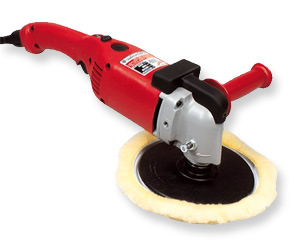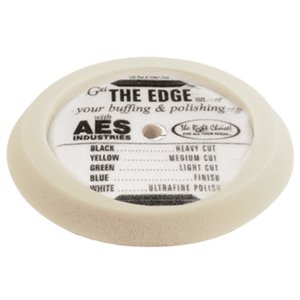|
|
|
|
#1 |
|
Stock
Join Date: Sep 2010
Location: Tulsa, Ok
Posts: 22
 |
Waxing:
NEVER WAX OR BUFF HOT PAINT...PERIOD! I could give you a plethera of horror stories here...suffice it to say you don't need to apply half a can of wax and leave it on your car for 3 days. Yes, I've actually seen it done.... Stay away from any products made by Simoniz or TurtleWax. You'd be better off pissing on the paint after you wash it. They are full of gorilla snot (silicone) and other additives that do no good for your car. The same goes for Colorback 2000, and all those other "once a year" products. If you care about your car so little, call me and I'll come get it... Here's what I recommend, Malco Imperial Paste Wax:  Simply the best product I've ever used for waxing a car. You may have to go online to buy it, and it costs a bit more per can, but this one can of wax will last you 10 years with your personal car. Yes, I know I said these were products that you could buy almost anywhere, but the fact is nothing on the store shelf comes close. Application: Keep a small container full of warm water. About the size of a coffee can should do. Wet your applicator by submerging it and squeezing 2-3 times, pull it out of the water and squeeze it twice. Now you're ready to apply the wax. After each body panel or two, re-wet and re-squeeze it for best results. Start in the same place on the car every time, and go in the same direction. Swipe the applicator in the wax, and wipe it on the paint in a straight side to side manner. One swipe through the wax should get you a body panel or two...it doesn't take much. Follow the body lines of the car to keep from skipping spots. Once you've made it all the way around, remove the wax with very soft terrycloth or microfiber towels. If it's your first time with this wax, repeat the process a second time...wax on, wax off. The Malco Imperial wax should last you a month or two, depending on how much you wash the car. It won't build up on your paint even if you use it every week. Feel free to use it on your chrome and your exterior windows too. Tomorrow, we're gonna start buffing.... Last edited by Jackalope501; 11-16-2010 at 02:34 AM. |
|
|

|
|
|
#2 |
|
3" Exhaust
Join Date: Oct 2010
Location: kansas
Posts: 166
 |
 more , more . Yesss this is like a porn movie lol , the more you see the more you want it!!! lol THANKS MAN !!!!!! more , more . Yesss this is like a porn movie lol , the more you see the more you want it!!! lol THANKS MAN !!!!!!
__________________
Nice 87 Supra, Pearl white, targa top, 5 spd, 7mgte  ARMY STRONG !! La fiebre Boricua Puerto Rico!!! 
|
|
|

|
|
|
#3 |
|
Stock
Join Date: Sep 2010
Location: Tulsa, Ok
Posts: 22
 |
Thanks Fantasma...love the enthusiasm.
Buffing: This is the most complex part of auto care, period. To give it it's due attention, this will probably require multiple posts over the next few days, so please bear with me. Machine buffing can make a dramatic difference in your paint's appearance, both good and bad. If this is your first time handling a buffer, I strongly suggest you attempt glazing first which I'll cover as we go along here. So let's get started with equipment first. Tools you will need: First off you will need a buffer, so let's talk about brands and features. The buffer you want to use is a variable speed model like the Makita shown below with a white foam pad attached. This is a glazing pad, more on that later...  Makita makes a good buffer. It's relatively light-weight, so it's easier to handle than say a Milwaukee, shown here wearing a white wool pad. This is a cutting pad.  What's the difference? Price for one. The Makita can be picked up for around $200 USD, while the Milwaukee will run $300+. Weight is also a factor. The Makita comes in at about 6.5 pounds, while the Milwaukee tips the scales at a hefty 9 pounds. This may not sound like a lot, but believe me it will beat your ass over the course of a day. Now don't get me wrong, I own a Milwaukee myself...it's the buffer I learned on many years ago, and it's a tough machine to beat. It's an extremely reliable bullet-proof piece of equipment, and the extra weight is a plus when you have to do heavy compounding jobs. The Makita motor produces about 10 amps, while the Milwaukee runs a wrist snapping 12 amp motor. The Milwaukee is probably the most common machine among professionals, but you're not likely to see one in the detail shop at your local auto dealer. There's a couple of reasons for this...first, I said it was common among professionals, not the lot porters you find spinning pads at a dealership. Most importantly, it's a theft issue. High-end Milwaukee buffers have the best resale value in their class, so a lot of them found their way into pawn shops. (Good place to buy one) For this reason, you'll find lower end equipment in dealer's shops. Here's a good example made by Chicago tools:  This machine retails for about $30-40 USD, so you can see why dealers buy them for their shops. It claims a 10 amp motor, but it's no Makita. It does feature variable speed, but it takes a while to spool up to 3000 rpm...trust me, I have one. Why? It's a good lower speed buffer for glazing at 1800 rpm. If you're a first time buffer, buy the Chicago. If you'll only buff one car in your life, buy the Chicago. If you're looking for a glazing machine to keep on hand so you don't have to keep swapping out heads and pads, buy the Chicago. It won't break your budget...at this price, you can afford to keep it on the shelf for 10 years. It's got enough power to buff a car, but not enough to get you into trouble like the Milwaukee. Oh, and before I forget....  For purposes of this discussion, this IS NOT a buffer. This is a plastic child's toy, and you can do a better job by hand. Don't waste your money. Last edited by Jackalope501; 11-17-2010 at 05:50 AM. |
|
|

|
|
|
#4 |
|
Stock
Join Date: Sep 2010
Location: Tulsa, Ok
Posts: 22
 |
Let's move on to pad selection...
There are several varieties available, but we'll start by breaking it down into two groups. Wool and foam pads. Wool Pads: These are agressive cutting pads. You will hear me use the terms "hard" or "soft" pads. This refers to their cutting power, or abrasive levels. How do you tell the difference? By color. Your most aggressive pad is a white wool pad, shown here with a velcro backing.  This is your most common form of attachment. You will use a 7" rubber backing plate on your machine with the male side of the velcro. These typically come with a new machine. The female velcro side will be on the back of the pad itself. That's hook and loop fastener for you military types. Your white wool pad gives you your best cutting power. That means it removes more oxidation and scratches. For most applications, this is where you start. This is also the pad you will use with heavier compounds. Next is your yellow wool pad, shown here.  This is a softer wool blend, used as a finish pad. Simply put, this shines more than a white pad does when used with the same products. So let's review...White pad = cut...Yellow pad = shine Here's a typical kit from buff and shine...probably the best pads you can buy.  This kit comes with a white wool pad, yellow wool pad, a black foam pad and the backing plate for all 3. At $32.oo USD, it's a bargain. I'll add the link here for anybody shopping. http://www.tooltopia.com/buff-and-sh...n=shopzilla_r1 Last edited by Jackalope501; 11-17-2010 at 06:32 AM. |
|
|

|
|
|
#5 |
|
Stock
Join Date: Sep 2010
Location: Tulsa, Ok
Posts: 22
 |
Use and cleaning for wool pads:
One of the next products you'll need for your wool pads is a buffer spur.  This is what you use to clean your wool pads while you're buffing. You can pick one up for about $5.oo-6.oo USD, so there's no excuse for stabbing the pad with a screwdriver to clean it out. This is a quick way to destroy some pads, and downright dangerous. Watch how fast a wool pad spinning at 3000 rpm on a high-torque motor can sling something, and you'll understand. Your buffer spur is also essential to breaking in a new pad when you buy it. You can't use them right out of the box or you, your car, and everything nearby will look like a chia pet. The yarn on a new pad is very thick and fluffy, and it will throw copius amounts of fuzz everywhere. you'll need to wash and spur the pad several times before you can buff with it. Spurring the pad: Place the buffer against your leg with the pad facing away from you. With your machine set at 3000 rpm, pull the trigger and place the spur against the face of the pad so the wheels spin with the pad itself. This should basically look like the needle arm on a record player, for those of you old enough to remember what they looked like. Run your spur across the pad face from inside to outside edge until the pad stops throwing dust. Your pad will get gummed up with your polishing products while you use it, so you'll do this several times while buffing a car. Now you know how it's done... You can wash your pads in the washing machine on the gentle cycle with normal detergent, but it has a tendency to warp them. A warped pad doesn't stay on the backing plate very well. For this reason, I hand wash pads in the driveway. Use your hose, a stiff brush and a bucket of soapy water. Dunk the pad, scrub it and rinse it well. Repeat a few times when breaking in a new pad. Let's say you've buffed with it already on a red car. Now your white wool pad is pink. Spray it down while it's still dry with your 50/50 degreaser mix, then wash it. Drying pads is the fun part, cause they hold a lot of water. Start by tossing the pad (wool side up) like a frisbee up and down your driveway. This knocks out excess water. Do this until it quits leaving wet rings on the pavement. Now attach it back onto your buffer and spur the pad to remove the remaining water. Yes, you'll get a little wet doing this...suck it up. Once the pad stops misting, set it out in the sun to finish drying. On a warm day this should only take about an hour. This is why you want to have at least 2 of each pad type you use. NEVER put a buffer pad in the dryer...EVER. Last edited by Jackalope501; 11-17-2010 at 07:29 AM. |
|
|

|
|
|
#6 |
|
Stock
Join Date: Sep 2010
Location: Tulsa, Ok
Posts: 22
 |
Foam Pads:
These are glazing pads. They are also color-coded to reflect their abrasive levels, but pay attention because the colors are reversed here. Yellow foam pads are more abrasive "cutting pads".  White foam is a fine finish pad.  Now you'll notice on the back of this white pad they put a color-coding chart on here. This is why I chose this photo. This is supposed to be the standard, but it's not always accurate. The white and yellow foam pads are consistent in their cut ratings, but the other colors are not. It's always a good bet to check the packaging and talk to the sales rep when buying blue, green or black pads. You see here that the black pad is rated for "heavy cut" from this manufacturer. I have 2 black pads in my shop that are softer than my white ones. See my point? Cleaning foam pads is also different. Toss them in a sink of warm soapy water and massage them. Don't use hot water or get too violent with them...the velcro is attached to the foam with adhesive. They can be a bit fragile. Rinse them in cold water, squeeze out the excess and set them out to dry. Instead of spurring them like your wool pads while you're buffing, use a damp terrycloth towel on the pad face while you spin it at 1800 rpm. Last edited by Jackalope501; 11-17-2010 at 07:59 AM. |
|
|

|
|
|
#7 |
|
Stock
Join Date: Sep 2010
Location: Tulsa, Ok
Posts: 22
 |
Now that we've talked about the pad types, let's discuss how to use them. Yes, there is a big difference between buffing and glazing, and you don't always need to do both. For basic principles, let's define them both.
Buffing: Here we're spinning a wool pad with a more aggressive product to remove oxidation and scratches from the paint at higher rpms. Normally 3000. Buffing products have different levels of silicates (sand) in them to accomplish this. Heavy compounds will feel gritty between your fingers like toothpaste, while products like Malco's Lite Finish will have more of a hand lotion type consistency. Glazing: Now we're spinning a foam pad at lower rpms, around 1800, with a wax or polymer based product to seal the paint, remove swirl marks and/or enhance the shine on the car's finish. The buffer speed combined with the material of the pad produces heat that's used to break down the product and push it into the paint. Buffing products break down at higher heat than the glazing products do, which is why we glaze at lower speed settings. When to buff or glaze? Let's say your paint feels dry to the touch. You put your hand on the hood palm down and pull it to you and it sounds like this...eeeeeeeeeeeeeee. But the paint isn't oxidized or scratched up. Glazing it will do. Glazed and waxed paint will feel soft, warm and smooth. If you have oxidation(chalky appearance) and scratches in the paint, it's time to buff. The standard rule of thumb is this...if you can prick the scratch with your fingernail, you won't get all of it out. I've compounded deep scratches out of cars before, but you're gonna burn through some layers of paint to do it. Not something for an inexperienced person to attempt. Buffing creates a lot of heat and friction, so burning the paint is easy to do. You can destroy a car's finish quickly if you don't know what you're doing, which is why I recommend you start by glazing until you get the hang of it. Everybody burns cars while buffing. Anybody who says they haven't has never buffed. Two types of burns: Working burns- These occur due to failing paint or clearcoat, or around sharp body panels where the paint is extremely thin. One simple pass can do it, and you won't notice it until the damage is done. Oops, now you gotta fix it... Neglect burns- These occur due to an idiot with the buffer who stays too long in one place, or grinds the edge of the pad against the paint. An example would be buffing around a spoiler and bumping the pillar with the edge of the pad. That's why we do those areas by hand, and you always mask rubber body trim. Now it's time to fire somebody... Now here's where it gets complex. Let's say we've got a dark green Chevy truck to work on. Fairly common color for them, right? It's got some oxidation and a few fine scratches. We can buff this out with Lite Finish and a wool pad, wax it, and be done. Next we have a dark green Nissan truck with the same problem. Once we buff it out with Lite Finish and a wool pad, we'll have to glaze it with a foam pad and Phase II glazing product before we can wax it. Why? Because GM uses a harder clearcoat than Nissan and other auto makers do. Softer clearcoats are prone to swirl marks after you use a wool pad on them, especially with darker colors. Lexus black is a bitch. We'll cover that more later... Tomorrow I'll start covering buffing and glazing products... Last edited by Jackalope501; 11-17-2010 at 08:51 AM. |
|
|

|
 |
|
|
 Similar Threads
Similar Threads
|
||||
| Thread | Thread Starter | Forum | Replies | Last Post |
| Current Ride, Mustang 5.0 | cageceo | Show n Tell | 28 | 08-10-2007 08:15 PM |
| Car Paint Maintenance, and cleaning. | cageceo | Exterior , Interior, and Detailing | 1 | 08-09-2007 05:43 AM |